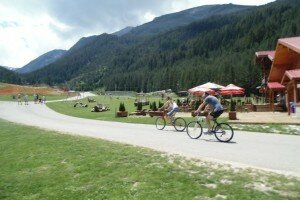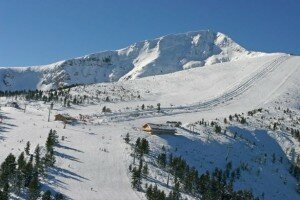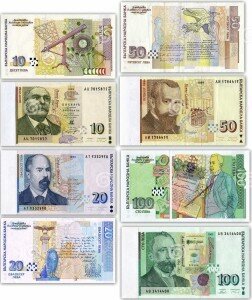Bulgaria Climate
In the higher parts of the country winters are colder and the summers pleasant and fresh. Snow may lie until June on the highest mountains. There are opportunities for winter sports in the mountains. Although the climate is generally temperate and pleasant, its variability throughout the year means that it may at times be uncomfortably cold in winter and rather warm and sultry in summer. 
Spring can be a very changeable season with rapid alternations between warm and cold days. Daily hours of sunshine range from about two in January to as much as ten in midsummer.
The largest areas of lowland are along the coast and in the valley of the river Maritsa in the centre of the country. Here the summers are warm and occasionally rather hot, while winters are fairly cold . Rainfall is moderate and well distributed throughout the year with slightly more in the summer. On the coast in Varna the winters are slightly warmer, but even here, spells of bitterly cold weather can occur when winds blow from the northeast carrying cold air from the Russian Federation. During such cold spells the Danube and other rivers may freeze over.
When taking a winter skiing holiday in Bansko, you should consider in advance that the Pirin mountain has a predominantly Alpine climate, which influences the weather of the town during the year. The average annual temperature in the town is often around 9 degrees Celsius. In order for you to have a pleasant holiday in Bulgaria, consider that in December, January, and February the temperatures here are usually the lowest, and in July or August, the highest.
Bansko Weather – Winter Season
The winter in Bansko is often cold and long. On average annually, the stable snow cover for this Bulgarian winter resort holds for about sixty-two days. And in general, the average January temperatures are around -5 degrees in the valleys and ski resorts, and even up to minus twenty degrees on the higher peaks in Pirin. On the other hand, snow cover here typically lasts for five or six months – from December to April – on the north slopes of the mountain, or sometimes until the end of February. It is over five feet of 1,5 meters thick. As usual summer temperatures in Bansko vary from fourteen to nineteen degrees Celsius. That is why, summer tourist season in this small picturesque mountainous Bulgarian town almost always starts in June and ends in September. If you tend to visit Bansko in the summer, do not forget that some rainy days are also typically possible here.
In summer the lovers of the extreme sports could hire the latest models of mountain bikes and enjoy a wild off-road ride. The ski routes and even some of the ski runs could be used as routes for mountian biking. The fine summer makes picnics and hikes a very enjoyable pass time. The vicinity of Chalin valog has designated picnic spots , huts and open BBQ areas with benches and mineral water basins, as well as delightful meadows.
has designated picnic spots , huts and open BBQ areas with benches and mineral water basins, as well as delightful meadows.
There are outdoor and indoor tennis courts, football pitches, a multitude of urban parks, shops and wellness spa centres in the region offering an enjoyable holiday in summer both to those who enjoy an active time and those who fancy a quieter cultural holiday.
In summer,the altitude of the Bansko region offers a hideaway from the heat, making it a favourite destination for local and international tourists alike.
Currency, payments and foreign exchange
The official monetary unit in the Republic of Bulgaria is called the LEV. As since 1997 the country has been in the conditions of a currency board, the Lev was pegged to the German Mark (at a fixed exchange 1 Lev for 1 DM) and since 1st January 2002 the Lev has been pegged to the Euro. Through the cross rates of all other currencies, foreigners and Bulgarian citizens willing to exchange foreign currency can easily compute the respective value of their money.
The Leva in Bulgaria are of emissions not earlier than 1999. The following coins are in circulation:
1 stotinka
2 stotinki
5 stotinki
The above mentioned coins are made of a copper,brass and yellow alloys and are therefore yellow/gold in colour.
10 stotinki
20 stotinki
50 stotinki
1 Leva
New 2 Leva coin released in December 2015
These coins are made of white metal alloys. The value of one stotinka amounts to 0.01 of 1 Lev.
The Bulgarian paper notes comprise the following denominations: 
2 Leva, with the effigy of Paissii Hilendarski;
5 Leva, with the effigy of Ivan Milev;
10 Leva, with the effigy of Dr. Peter Beron
20 Leva, with the effigy of Stefan Stambolov
50 Leva, with the effigy of Pencho Slaveikov
Currency may be exchanged in all Bulgarian banks from Mondays through Fridays in the regular working hours without any commission charged. A lower bank exchange rate is quoted by the exchange bureaus at the major hotels, railway stations, bus stations, maritime ports, and international airports. Money can be exchanged also in the numerous private exchange bureaus, some of which are open throughout the week , and others operate non-stop.
Customs regulations
Every tourist visiting the Republic of Bulgaria may import a limited amount of food, cigarettes and alcohol for personal use. Depending on the length of his stay, the admissible number and quantity of the imported goods is indicated at every customs checkpoint.
A special customs declaration is filled should the imported amounts exceed the stipulated quantities, together with an explanation for the reason of this excess. Subject to obligatory declaring are golden articles, valuables in excess of personal jewellery, photographic cameras, electronic devices and apparatus of greater value. The same objects shall be declared also upon leaving Bulgaria, whereby the tourist certifies that the objects have not been made present or sold to other persons. Presents and objects carried for Bulgarian citizens or foreigners residing in Bulgaria shall be declared as well.